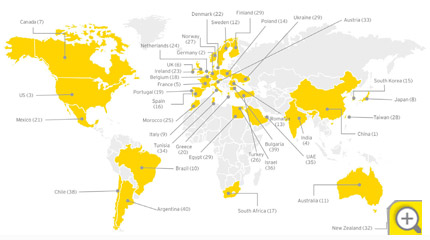Alternative Energy Attractiveness Indices
New markets have ricocheted across the renewables sector, injecting some much-needed optimism and competition into an industry that remains scarred by the enduring legacy of the financial crisis.
Emerging markets are already learning from their predecessors’ mistakes, with many opting for capacity tenders in favor of financial incentives.
With more developed markets buckling under the pressures of continuing economic tumult, political change and social pressures, it is perhaps of little surprise that the top-ranking countries in our index have seen scores fall even further in Q3.
Our Country Attractiveness Indices (CAI ) score 40 countries on the attractiveness of their renewable energy markets, energy infrastructure and the suitability for individual technologies. The indices provide scores out of 100 and are updated on a quarterly basis. The map below reflects the ranking of each country in this issue.
Grid issues, strong partisan views, mixed policy signals and austerity measures are just some of the tensions that are slowing the pace of expansion across our top five countries.
This issue sees the US fall to third place behind Germany, as policy uncertainty continues to undermine the sector. Even Germany, so long a beacon of optimism, has seen rising energy costs for consumers prompt its policy-makers to rein in support for renewables.
However, it is premature to write off these markets so easily. Each is simply trying to carve out a sustainable role for renewables in the face of competing agendas and short-term barriers.
Emerging markets on the other hand – with untapped resources and high levels of government support – are already learning from their predecessors’ mistakes, with many opting for capacity tenders in favor of financial incentives.
Increasing energy demand in these regions has strengthened government investment in clean energy. Our two new entrants to the index – Saudi Arabia and the United Arab Emirates (UAE) – are also supported by strong government initiatives, a proven track record in energy infrastructure, and robust financial markets. However, these markets and others will also need to find ways to attract more private investment if they are to avoid overreliance on government-driven growth.
The real casualties of 2012 have been the sector’s manufacturers. Oversupply, falling technology costs, reduced demand in some European markets and ensuing trade protectionism have resulted in supply chain paralysis across some markets. Many manufacturers are likely to be left out in the cold as governments rationalize financial support and corporates favor divestment and restructuring.
In the long term, greater cost-competitiveness should create a sustainable growth platform for both developed and emerging markets as well as manufacturers. Until then, however, Darwin’s “survival of the fittest” will inevitably result in some sector players becoming extinct along the way.
